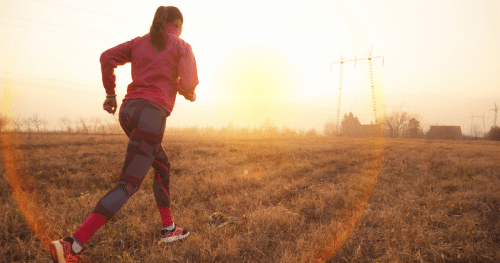Hormones are important in regulating key functions in the body, and when they are out of balance, they can negatively affect your health and wellbeing.
Levels of two of the main sex hormones, oestrogen and testosterone, can decline or become unbalanced with age, but what can you do about it?
Facts:
- Two of the main sex hormones, oestrogen and testosterone, play a role in sexuality, fertility but also muscle growth, body fat, mood, bone health and more.
- Although found in differing levels, both oestrogen and testosterone are found in males and females.
- A high amount of oestrogen is made from body fat
- Healthy lifestyle is important for hormonal balance
What is oestrogen?
Oestrogen is one of the main female sex hormones. It is needed for puberty, the menstrual cycle, pregnancy, and bone strength. Levels of this hormone fluctuate throughout life, to control body processes including the menstrual cycle.
Oestrogen is made from testosterone and in women, it is mainly produced by the ovaries, but also in breast, fat, and bone tissue. In men it can be produced by adrenal glands and the brain (1).
Oestrogen levels peak in the mid-to-late 20’s in women and then decline by approximately 50% at around 50 years of age, and dramatically decrease further after menopause.
What is testosterone?
Testosterone is one of the main male sex hormones which is vital for the development of male productive system during foetal development, and then again at puberty.
It is important for hair growth, deep voice, sperm and semen production, bone health, increased muscle mass and increased libido (sexual desire).
For men AND women, testosterone is a major promotor of muscle growth and strength (2).
What happens when hormones become unbalanced?
When oestrogen levels are too high in women, symptoms in women may include breast tenderness, headaches, weight gain, low mood and irregular periods. When too low, symptoms can include low libido, hot flushes, osteoporosis, irritability, vaginal dryness, dyspareunia (pain around sex) and irregular periods. In men, high levels of oestrogen can lead to; gynaecomastiaI (growth in breast tissue), infertility and sexual dysfunction (3).
Low testosterone can also lead to side effects in women which include low libido, low energy, cognitive impairment, and low mood. When testosterone is too high in women, it can lead to acne, hirsutism, irregular periods, infertility, male-pattern baldness, weight gain, polycystic ovary syndrome (PCOS). For men, low testosterone can result in reduction in muscle mass / increase in body fat, loss of body hair, low mood, erectile dysfunction, poor libido, osteoporosis, poor concentration/memory, infertility and hot flushes (4).
How do oestrogen and testosterone levels change with age?

- For men and women, testosterone levels decrease with age.
- For women, oestrogen levels vary hugely throughout our life, and per month. Oestrogen levels, like testosterone, gradually decrease with age and drop significantly at menopause.
- For men, oestrogen can increase with age, although unless abnormally high, symptoms and health risks are not of concern.
How can we regulate hormones through lifestyle?
- Maintain a healthy body weight
- Get more sleep
- Reduce stress levels
- Reduce alcohol, smoking, drugs and steroids
- Exercise regularly
How does maintaining a healthy body weight lead to hormone regulation?
Higher levels of fat can lead to an increase in oestrogen production. This is because oestrogen is produced in the ovaries and by adipose (fat) tissue. Maintaining a healthy body weight will promote a healthy BMI and keep body fat levels in the ideal ranges. Less fat tissue will be available to convert into oestrogen.
How does exercise affect hormone levels?
- Testosterone and oestrogen are both positively regulated by exercise
- Testosterone levels are generally boosted by exercise (5). Research has shown that testosterone levels increase for a window of around 30 minutes after resistance training
- Moderate exercise, such as a 30-minute jog or cycle, can boost testosterone levels
- Regular exercise can manage body weight which can help to keep oestrogen levels optimal. It can also have a positive effect on oestrogen metabolism which can reduce the risk of some cancers
How Uniquely Health can help you
- Blood testing of key health biomarkers, along with clinical assessment to identify areas that need improvement
- Action plan to balance your hormones through clinical, fitness and nutritional interventions
- Support, accountability and adaptability to suit you
Key Conclusions
1. Two of the main sex hormones, oestrogen and testosterone, play a role in sexuality, fertility but also muscle growth, body fat, mood, bone health and more.
2. Hormones change with age, but more significantly for women, which can present various symptoms.
3. You can help maintain healthy hormone levels through managing bodyweight, and living a healthy lifestyle.
If you are looking for support with your hormone health then book a complimentary call with our team to discuss how we can help you.
- Delgado, B. J., & Lopez-Ojeda, W. (2023). Estrogen. In StatPearls. StatPearls Publishing.
- Nassar, G. N., & Leslie, S. W. (2023). Physiology, Testosterone. In StatPearls. StatPearls Publishing.
- Patel, S., Homaei, A., Raju, A. B., & Meher, B. R. (2018). Estrogen: The necessary evil for human health, and ways to tame it. Biomedicine & pharmacotherapy = Biomedecine & pharmacotherapie, 102, 403–411. https://doi.org/10.1016/j.biopha.2018.03.078
- Torjesen, P. A., & Sandnes, L. (2004). Serum testosterone in women as measured by an automated immunoassay and a RIA. Clinical chemistry, 50(3), 678–679. https://doi.org/10.1373/clinchem.2003.027565
- Riachy, R., McKinney, K., & Tuvdendorj, D. R. (2020). Various Factors May Modulate the Effect of Exercise on Testosterone Levels in Men. Journal of functional morphology and kinesiology, 5(4), 81. https://doi.org/10.3390/jfmk5040081









